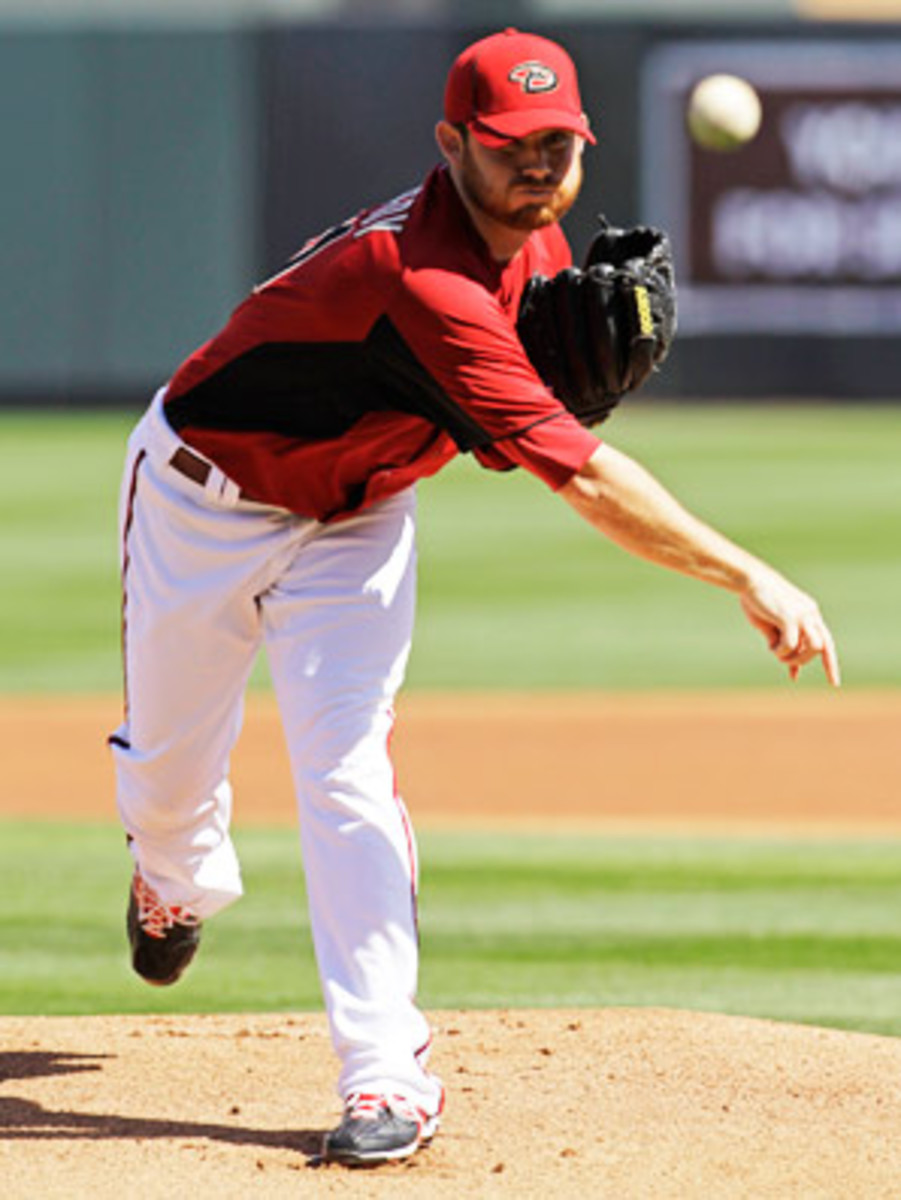Kennedy toiled to reach the top -- now the trick is staying there


SCOTTSDALE, Ariz. -- Ian Kennedy reported to the Arizona Fall League two and a half years ago and wanted to make up for lost time.
"I tried to work on my two-seamer and throwing my offspeed for strikes," he said of his 2009 stint for the AFL's Surprise Rafters. "I didn't care about numbers. I just wanted to get better as a pitcher and, honestly, get some innings, because I had the aneurysm surgery."
Scouts populate the grandstands for every game in the AFL, an advanced autumnal circuit for prospects, but Kennedy's plan for personal development after missing four months with his health ordeal had some unexpected consequences. He pitched really well, despite using the time to experiment with new pitches. He had a 4.25 ERA in the hitter-friendly league, with a 28-to-5 strikeout-to-walk ratio in 29 2/3 innings.
During his month and a half pitching in the sun, Kennedy never realized that one particular scout attended each of his starts, in hopes of making the young right-hander a permanent resident of the Valley.
Jerry Dipoto, then the Diamondbacks' senior vice president of scouting and player development, watched every pitch Kennedy threw, and came away duly impressed.
"He was outstanding every time, right through the championship game of that league," Dipoto, the Angels' new general manager, recalled last fall.
Arizona needed to improve its rotation after Brandon Webb had made only one start that year and had uncertain shoulder health. The club wasn't concerned with necessarily finding a substitute ace at the time -- just a quality pitcher on whom they could depend for several years.
Barely two weeks after the AFL season ended, the Diamondbacks, Tigers and Yankees made the game-changing three-way trade that defined the 2011 season: Among the players moved were Curtis Granderson to New York, Austin Jackson and Max Scherzer to Detroit and Kennedy to Arizona.
"The natural vernacular that everybody wants to say is, 'Is this a No. 1? Is this a No. 2?'" Dipoto said, dismissing the importance of such nomenclature. "We had identified [Kennedy] clearly as a very good fit for us. He was young, controllable and had a quartet of pitches he could control to different areas of the [strike] zone, and we felt like he could deliver quality innings."
His first year with the Diamondbacks was fine (9-10, 3.80 ERA in 194 innings), but in 2011 the 26-year-old Kennedy hit his stride. He went 21-4 with a 2.88 ERA, 1.09 WHIP, a 3.6 strikeout-to-walk ratio and 198 strikeouts in 222 innings; the wins led the NL while the other numbers were all top-10. He finished fourth in the NL Cy Young voting, and even received a first-place vote.
"He knows what he's doing," catcher Miguel Montero said. "He may seem easy-going, but he's not. He's intense. I think that's one of the reasons why he's pitched so well. The other is that he's well prepared."
In New York, Kennedy was a hyped prospect and a former first-round pick unfairly thought to be a failure because of poor performance in a small sample size. In Arizona, however, the man whom Dipoto described as "a cerebral pitcher" assumed the role of a No. 1 thanks, in part, to his willingness to innovate.
* * *
Ian Kennedy joined the Mayaguez Indios and couldn't throw his slider.
"The seams were huge," he said of his month in the Puerto Rican winter league in 2008. "They were like high school balls."
Left without an important pitch in his arsenal, Kennedy, then a Yankees prospect, began throwing more cut-fastballs, a pitch he had been messing around with in side games of catch but hadn't used in competition.
"It's not that hard to throw," Kennedy said. "You throw it like a fastball and just grip it differently, and it comes out like a cutter."
The following year Kennedy was working out in Tampa when Yankees V.P. of player personnel Billy Connors, a former big-league pitching coach, helped him make the cutter a more regular part of his arsenal. Later, Kennedy asked Andy Pettitte about the pitch, too. (He never broached the subject with the unquestioned expert, Mariano Rivera, whom he didn't know as well.)
While the seeds of the cutter were germinating -- his use of the pitch has steadily grown each year hence -- Kennedy's brief stint wearing pinstripes didn't go as planned. He had a 6.03 ERA and, even though he had battled through a major health issue and hadn't yet completed 60 big-league innings, New York seemed ready to dismiss him.
"I learned a lot on how to deal with failure," he said. "I had never failed like that, on that big a stage before. For me, developing at that level so quick really helped a lot."
* * *
Ian Kennedy leaned against the cage and followed Derek Jeter's advice.
"Derek Jeter told me, 'Stand behind home plate during batting practice,'" Kennedy recalled the Yankee captain saying. "'See how many pitches that we mishit.'"
Much is made of a pitcher's performance improving when he moves from the American League to the National League. Facing a pitcher in the lineup and not a designated hitter in the lineup makes a difference.
But Kennedy believes there's another factor in play: That he, the pitcher, is in that lineup.
The experience from the other end of a pitch was a revelation. He appreciated how hard hitting can be. Even balls he squared up often found a fielder's glove. Watching other pitchers work undoubtedly helped too.
"You figure they hit everything," he said of major league hitters. "No, they don't. That's what I've learned. They get themselves out more than we get them out. That's how I view it."
In that case, why not challenge them more? In 2011 Kennedy threw 67 percent of his pitches for strikes, the eighth-highest rate among qualified starters. According to FanGraphs.com, roughly 71 percent of his pitches were fastballs (four- and two-seamers) and cutters, and hitters swung at a career-high 68.1 percent of his pitches.
"It's hard to hit a fastball as it is, but if it's moving, it's harder to hit," he said. "Now that I'm hitting, I realize that."
He cut his walk rate from 3.2 per nine innings to 2.2, and he needed, on average, one fewer pitch per inning to retire the side, allowing him to go deeper into games.
Kennedy's primary pitch remains the four-seam fastball. "He can rush it up there and has a little more in his tank than people give him credit for," pitching coach Charles Nagy said.
But the way he mixes in its complementary pitches -- the two-seamer and cutter, the ones he honed in Puerto Rico and Surprise -- have helped Kennedy realize his potential as Arizona's No. 1 starter.
* * *
Ian Kennedy watched Greg Maddux pitch and considered what it meant to be an ace.
"Growing up, whenever I thought of an ace, I thought of somebody that was consistent," Kennedy said, "that you know what you're going to get and that every time they go out there, you have a really good chance of winning. I always wanted to be like that."
That sounds exactly like the Maddux of Kennedy's childhood, but also an awful lot like what Kennedy did in 2011, even if he won't finish the next step of deduction and proclaim himself to be an ace, whether that reluctance is born out of humility or a desire to repeat his high level of success again first.
The Diamondbacks themselves are in a different place then they were a year ago. Before last season, many thought they were doomed to fourth or fifth place.
The team's meetings last spring under Kirk Gibson, the newly named full-time manager, were about changing the culture and the introduction of big ideas.
After an unexpected NL West title, this year's spring meetings are about refinement and enhancement of the foundational ideas already in place. "I like these meetings way better," Kennedy quipped.
While 2011 may have been a charmed season -- even Kennedy called it "a good year that will be hard to duplicate" -- his own 2012 performance will, like the team, merely be about building forward, which is something he's been known to do before.
